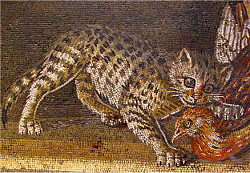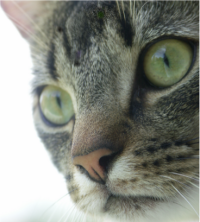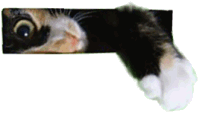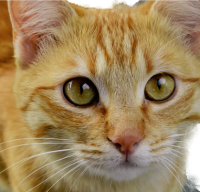Discovering what makes a tabby a tabby
Tabbies, with their stripes, dots and swirls on their coats, are one of the most popular types of cat. There are a number of different types of tabby, but most can be recognized by the characteristic dark M-shaped marking on the cat's forehead. Theirs Is a very old coat pattern, and tabbies can be seen on Greek vases and Roman mosaics.

A tabby cat shown on mosaic from the Roman city of Pompeii
The tabby is not a distinct breed of cat but rather the coat pattern expressed by some breeds. Different breeds of cats can be tabbies - for example Abyssinian cats, which are called 'ticked tabbies'. Though they donít have the characteristic stripes of 'mackerel tabbies', the individual hairs on an Abyssinian have bands of dark and light coloring. Abyssinian tabbies also have the distinctive M on their foreheads.
Although experienced breeders can successfully reproduce the tabby coat pattern, the science of how these stripes originally came to be has proven difficult to unravel.
Basically it comes down to genetics. Typically a 'mackerel tabby' (a tabby with characteristic long dark stripes) will have a so-called TaM/TaM or TaM/Tab allele on each chromosome whereas a tabby with a coat that has a blotched appearance will have different alleles called Tab/Tab alleles. (An allele is a particular gene sequence in a creature's DNA.)
A few years back a scientist called Christopher Kaelin identified two genes - Transmembrane aminopeptidase Q (Taqpep) and Endothelin 3 (Edn3) - as crucial in creating the pigment patterns on a cat's coat (Ref 1)
Most important is the 'Taqpep' gene which puts the stripes and spots on a cat's coat. Cats which have loss-of-function mutations in Taqpep do not develop a tabby's dark narrow stripes. Instead their markings are less well-organized and appear as large whorls or spots.

'M' is for 'Tabby'
Also important are genes which affect the base of hair follicles in tabbies. These are responsible for the coloring of individual hairs and are therefore key to the implementation of tabby pattern.
In their most recent studies (ref 2), Kaelin and his colleagues have observed that the skin of unborn tabbies has variable thickness.The thick and thin parts seem to alternate creating bands across the skin. The thicker skin bands will become the darker patches of fur in a fully-grown cat, and the thinner skin will have the strips of lighter color. The skin actually got thicker in the unborn kitten even before the hair follicles started to develop.
"We call this step 'establishment,' and it happens long before color appears and long before hair follicles are mature," said the co-author of a recent communication paper in the prestigious scientific journal Nature.
Focusing on the embryonic skin cells, the researchers found that one particular gene seems to be more active in the thicker areas of the skin. This gene is called Dickkopf 4 or Dkk4 for short. (Dick kopf is 'thick head' in German).
This gene encodes a protein involved in embryonic development through its interactions with the WNT genes which are present in all mammals and are involved in regulating cell growth and death.
Scientists believe that WNTs and DKK4 collaborate to form the pre-pattern which will establish the pattern of a tabbyís coat. This happens when embryos are only a few millimeters in length - weeks before pigment is produced in hairs. But how the pre-pattern of the genes is eventually translated into the hair pigment remains a mystery.
|
To prove that DKK4 is involved in creating the tabby coat, the researchers looked at Abyssinian cats. Abyssinian cats have a uniform hair pattern over most of their bodies, but the fur of those cats is ticked, so that on top of every orangish-brown hair there is a light shade of gray. It turns out that Abyssinian cats have disrupting mutations in their DKK4 genes and these prevent the formation of typical tabby markings.
"If you remove DKK4, the dark areas donít go away entirely, but they become smaller and more packed together," explained one of the researchers.
Are there more genes involved in formation of specific coat patterns? Most likely yes. The tabby is still hiding a few secrets under that distinctive coat.
References:
1. Christopher B. Kaelin, et al. Specifying and Sustaining Pigmentation Patterns in Domestic and Wild Cats. Science(2012) Vol 337, pp. 1536. https://www.science.org/doi/10.1126/science.1220893
2. Kaelin, C.B., McGowan, K.A. & Barsh, G.S. Developmental genetics of color pattern establishment in cats. Nat Commun (2021) vol 12, pp 5127. https://doi.org/10.1038/s41467-021-25348-2


